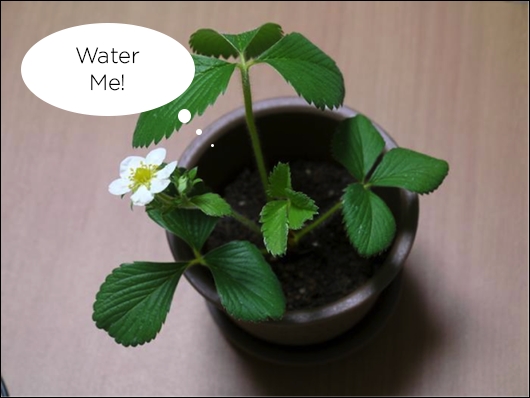You're reading from Arduino for Kids
Caring for a plant can be a lot of responsibility. After all, they are living things, and you wouldn't want anything dying on your watch!
Gardening can be complex, making sure there is enough sunlight or your plant is getting enough water. Things can go wrong if care isn't taken while tending to your plants.
But you are no ordinary gardener, are you? You are going to use the magical power of the Arduino to bring gardening into the 21st century! We are going to be using the concept of automation as well as the sensors and circuitry we have used before to make our digitally empowered plant!
Problem Statement: Build a smart-gardening system.
Solution: A system that can quantify the amount of moisture in soil, and automatically intimate a human being if the plant needs to be watered.
One of the biggest challenges we will be tackling in this project is to figure out if our plant needs to be watered or not.

We do this by measuring the moisture, or the water content of the soil that the plant is in. We will need to measure some quantifiable parameter that directly relates to the moisture of the soil.
This is where our sensor becomes important. As we have discussed before, a sensor is something that converts a physical parameter into an electrical signal that can be measured. In this case, the physical parameter is the soil moisture itself that we want to convert into electric signals.
Commercial soil moisture sensors estimate water content based on the dielectric constant of the soil. The dielectric constant can be thought of as the soil's ability to conduct electricity. The dielectric constant of soil increases as the water content of the soil increases.
This is due to the fact that the conductivity of water is much more than that of soil and its components...
You can visualize the soil to be a kind of resistor, similar to the LDR we used earlier. The lesser the water content, the more the resistance; and the more the water content, the lesser the resistance.
Now, before we try and figure out what kind of circuit to use for our project, we need to find a way in which we can connect our wires to the soil!
We know that metals are good conductors of electricity. We need to provide a voltage between two points in the soil. We can use a large metal object, like an iron nail that can be embedded into the soil such that it can be an interface between our circuit and the soil.
Usually, these objects that are used as an interface in order to make some measurement are referred to as probes. You might have seen doctors using probes used to measure muscle activity of an athlete:

Image source: http://i.ytimg.com/vi/yZ_nxY91yxI/hqdefault.jpg
Muscle activity of an athlete being tracked using muscle probes.
The following is an image...
This was a fun chapter to get you used to solving real-world problems. Think of ways in which this system can be improved by adding other sensors like an LDR or actuators like a water pump to make this project even better.
Let's recap what we learned:
Understanding the dielectric constant of the soil, which can be thought of as the soil's ability to conduct electricity
How we can interface the soil to our circuit using probes
Then we came across our super voltage divider circuit again
Using conditional statements to give our project logic
You have got through the journey in this book with flying colors, High-5! (Use the Bot!)
I hope what you have learnt so far would have changed your perspective of how you can do things by creating objects that can think for themselves and interact with you or the world around them.
This is just the beginning of the huge playground of sensors, actuators, electronics, and mechanisms out there that control everything from the automatic breaking system in cars...
 © 2017 Packt Publishing Limited All Rights Reserved
© 2017 Packt Publishing Limited All Rights Reserved